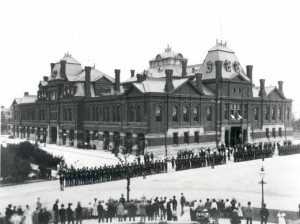
Or maybe “blackwashing” would be more accurate.
Bear with me for some context:
The Chicago Tribune had an article today about the Pullman National Monument, in particular, plans to create a mural featuring A. Philip Randolph, the head of the Pullman Sleeping Car Porters’ Union, which reminded me of the peculiarity of this retelling of history, connecting up the Pullman district with the Pullman union, and implying that the latter happened in Pullman rather than, in reality, in New York — I wrote about this back in February and linked to a Trib columnist who provided more detail.
But the article today I was struck by the fact that the history of the Pullman porters was identified as the heritage of its residents, and here’s a Fox News article on the National Monument designation, from March 1st, that makes this linkage even more forcefully:
Chicago bought the town from Pullman in the 1890s, and the neighborhood became officially incorporated into the Windy City. It has remained a primarily African-American neighborhood, with many longtime residents recalling firsthand the days before Pullman Company, as it was last known, turned out its last subway cars for Chicago, New York and Boston in the 1980s.
“It’s a fantastic place and I’m glad to be born and raised here and that my mother was born and raised here,” said Marilyn Gartelmann Quiroz, 74. “She came from a very poor family, but we raised ourselves up,”
Quiroz and her husband of 50 years, Al, joke they are third generation “Pullmanites.” Her mother was born in one of the blockhouses in Pullman, the same building that Quiroz’s husband would later be born in. Her father and her father’s uncle worked at Pullman, and her father’s uncle moved through the ranks from the bottom of the company to become a plant manager.
Great story, eh?
Except that the reality of racial segregation in Chicago means this didn’t happen.
Quiroz? The article implies that she’s black, don’t you think? But she’s not; she’s white (and on facebook), as is anyone with that much family history in Pullman.
Because for the first half of the twentieth century, blacks in Chicago were largely restricted to the “Black Belt” — a 30 x 7 block stretch along State Street, due to residential covenants and other restrictions keeping even middle-class blacks out of white neighborhoods. See this bit from Wikipedia, and the page on the Pullman-museum.org site about the connections between African-Americans and Pullman, and, for a very visible and dramatic illustration of the Black Belt and segregation, look at this time-lapse map of Chicago neighborhoods; Pullman is neighborhood #50, the rectangular one towards the bottom right. (See Wikipedia for further identification.) I’ve watched this repeatedly — Pullman doesn’t lose it’s majority-white status until 1970, and doesn’t become majority-black until 1980, as a consequence of subsequent white flight .
Remember Ta-Nehisi Coates’ The Case for Reparations? No, I’m not going to make you re-read it — I didn’t even re-read it just now. But I recall that a lot of his case, when it comes to Northern cities, was based on past racism in housing policy, exactly this sort of extreme segregation. Remember the Robert Taylor Homes, formerly the eyesore along I-94 as you head south out of Chicago? These massive public housing high-rises were built in order to squeeze as much public housing into the Black Belt as possible.
Which means that, in order to create history where there was none, to create this continuity between the current black residents and the union activity of the (white immigrant) Pullman factory workers, and subsequent unionization triumph of the (black) porters, this history of segregation had to be erased.
Hence, a “whitewashing”: in the sense of erasing a part of history; or, a, to coin a really clumsy term, perhaps it’s “blackwashing” — because if “whitewashing” is to make something appear as if it’s “white,” either figuratively, without problems, or literally, by removing racial minorities from the story, then here, it’s the white immigrants that are being removed from the history of Pullman, with the ironic consequence of removing the entire history of segregation.
Am I being nit-picky? I don’t think so. It matters that we get history right, rather than just come up with inspirational stories.












